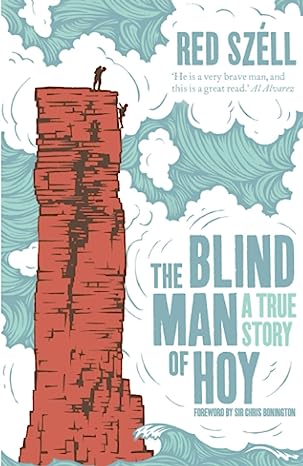Blind climber Red Széll calls for ban on advert boards on pavements
Town Hall chiefs say they will consider request but must get views of businesses as well
Tuesday, 18th July 2023 — By Richard Osley

Red Széll in the council chamber and an example of the style of pavement advertising which he said is proving an obstacle for people with white canes
A BLIND adventurer has said he feels safer on his rockface climbs than walking along pavements chock–full of advertising boards.
Red Széll last night (Monday) appeared at Camden’s full council meeting and appealed for ‘A frame’ adverts or ‘A boards’, often found outside shops, cafes and pubs, to be completely banned across the borough.
He said there were now too many obstacles, adding: “The problem is getting worse. On a 200 metre stretch of Hampstead High Street today, I encountered 11 a-frames and cafes with tables and chairs that encroach across the pavement so that it is impossible for two pedestrians to pass each other without one stepping into the road.
“Pavements are specifically designed to give safe passage to pedestrians. Allowing them to be used for retail and advertising purposes forces pedestrians closer to the kerb and into the path of street furniture like street lamps and parking meters. Local authorities across the UK have a legal duty to keep pavements clear from obstruction.”
Mr Széll became the first blind person to climb the ‘big three’ sea stacks in Scotland: the Old Man of Hoy, the Old Man of Stoer and Am Buachaille. He had watched and been inspired by mountaineers as a child but was told when he 20 that he would be blind within a decade after being diagnosed with retinitis pigmentosa. His story was told on a BBC documentary charting his climbing triumphs.
Mr Széll wrote a book about his sea stack triumph
“They are a bit like graffiti or fly-tipping. Once one appear then others gather very very rapidly,” he told the all-member meeting in the Town Hall chamber, in his assessment of the a-frame advertising.
“I ask the question: actually how much trade do they bring in? I’d like some figures, if it was me making the decision. How much trade do they really bring in? Or are we looking at a rather 1950s solution for advertising? I think it’s antiquated technology.”
He added: “I can see no good in them, to be perfectly honest. They are there solely to provide free advertising for buildings that quite often – and this is the case for a lot of pubs in Hampstead – they’ve got a sign hanging in the air. You don’t need another site or two sitting in the middle of the pavement blocking people in wheelchairs, with pushchairs and people with white canes.
“I actually think it’s one of things that we have due to tradition but it’s a tradition, like many others, that could fall by the wayside and we’d be in a better place.”

Labour’s environment supremo Councillor Adam Harrison
Environment chief Labour councillor Adam Harrison said: “In all cases, the current situation is that a minimum of 1.8 metres of clear passage must be maintained to ensure that people can get by and we do extend this when we need to in areas of very high footfall.”
He added: “Our team will be checking Hampstead High Street. We will be reviewing our own guidance to check it’s as robust as it can be and we will be considering your request for a full ban. We need to find a way to take into account all the viewpoints we have heard tonight, from the businesses and what data might be useful to take into account.”
Several councillors have taken awareness training with blindfolds to understand how an array of potential obstacles make life harder for the blind and partially sighted.
Mr Széll said he was aware that there was also a problem with dumped hire bikes and scooters, but said this would be harder to fix than tackling ‘a frame’ advertising with a ban.

